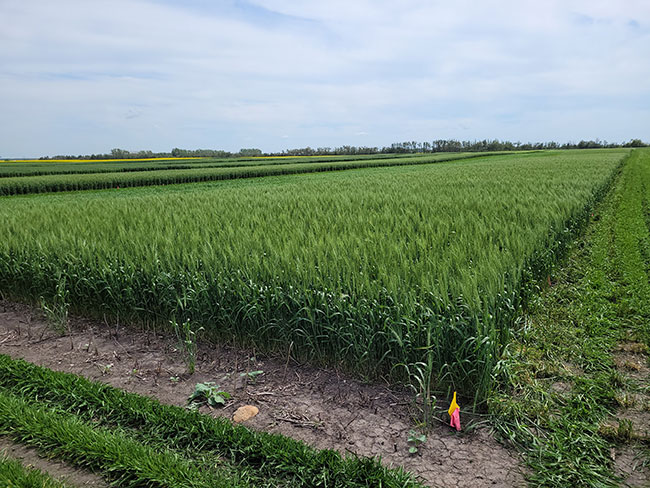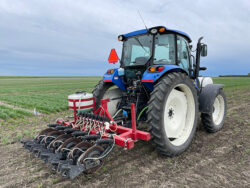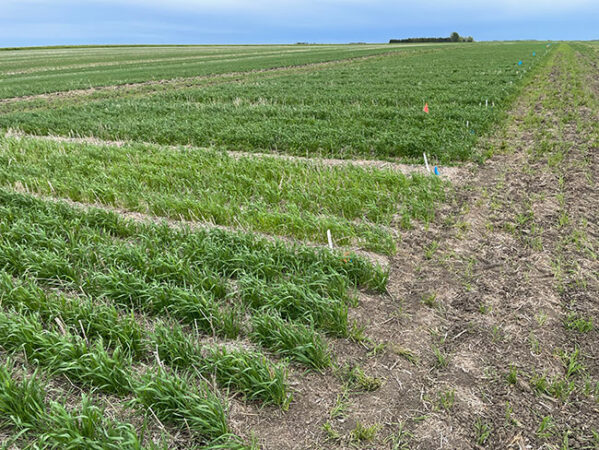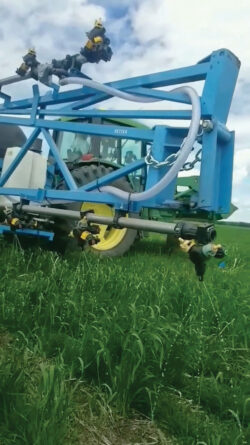
Features
Cereals
Environment
Managing drought risk in spring wheat
Can split N application in spring improve economics and maintain yields?
April 24, 2024 By Donna Fleury
 Study comparing the efficacy of various rates and timings of split applied N relative to applying all the N at seeding in spring wheat under drought conditions at Yorkton.
Photo courtesy of Mike Hall, ECRF.
Study comparing the efficacy of various rates and timings of split applied N relative to applying all the N at seeding in spring wheat under drought conditions at Yorkton.
Photo courtesy of Mike Hall, ECRF. Reassessing nutrient management strategies under drought conditions to determine the most economical approach can be challenging. Researchers in Saskatchewan wanted to investigate whether split applications of nitrogen (N) in spring wheat might be more economical than the commonly recommended practice of banding all of the N beneath the soil surface at seeding.
“In some areas of Saskatchewan, dry conditions have persisted for a couple of years, raising questions about nutrient management and the opportunity to improve economics with different strategies,” says Mike Hall, research coordinator at the Yorkton Agri-ARM Research Farm, East Central Research Foundation and Suncrest College. “With high background reserves of N and drought conditions in spring, the question is whether holding back on N at seeding and top dressing more N if conditions improve is an economically effective approach to N management. In collaboration with other Agri-ARM sites across Saskatchewan, we conducted a one-year study in 2022 to demonstrate the efficacy of various rates and timings of split applied N relative to applying all of the N at seeding in wheat across a range of environmental conditions.”
The study was conducted at six Agri-ARM sites across Saskatchewan, including Indian Head (thin Black), Swift Current (dry Brown), Outlook (Brown), Scott (Dark Brown), Yorkton (Black) and Melfort (moist Black). Results from Yorkton and Melfort are not included due to environmental and technical issues at these locations. Outlook was the only irrigated site included for comparison to the dryland sites.
The targeted N rates at seeding included the background soil N in the top 24 inches, plus applied fertilizer. The background soil N varied greatly as expected. For the economic analysis, N treatment costs were $1.33/lb., and the application cost for dribble banding UAN was $10/ac. The protein premium or discount was calculated at $0.66/per cent /bu above or below 12.5 per cent protein.

Dribble band application setup for spring wheat split application plots at IHARF.
Photo courtesy of Chris Holzapfel, IHARF.
The N response at Indian Head, Outlook, Scott and Swift Current was determined for five rates of soil + side-banded fertilizer N. Rates evaluated were soil N, 80, 110, 140 and 170 lb. N/ac. The 140 lb. N/ac. and 170 lb N/ac. levels of fertility, all side-banded, served as checks for the various split applications of N. Post-emergent split applications of N were dribble banded UAN mixed with Agrotain where possible to reduce the risk of volatilization loss. Application timing was either the three- to five-leaf-stage or early flag. At Indian Head, Outlook, Scott and Swift Current, split application at the 140 lb N/ac level of fertility was achieved by either dribble banding 60 lb N/ac. on a base rate of 80 lb. N/ac. or dribble banding 30 lb. N/ac. on a base rate of 110 lb. N/ac. Likewise, 90 lb. N/ac. was dribble banded on a base rate of 80 lb. N/ac., or 60 lb. N/ac. was dribble banded on a base rate of 110 lb. N/ac. for comparisons at the 170 lb. N/ac. level of fertility.
“The study results really showed that applying the recommended amount of N at seeding or holding back no more than 30 lb. N/ac., is still the best strategy under drought conditions,” adds Hall. “The risk of not being able to get out and apply the N should growing conditions improve, or if rains don’t materialize after the second split application, can result in substantial economic loss. For split application, the earlier application at the three- to five-leaf-stage maintains yield potential much better than waiting until the flag leaf, which can significantly reduce yield potential. While split applications sometimes resulted in a protein boost up to 0.5, it was usually associated with a yield reduction that reduces economic returns even when assuming a generous protein premium.”
The drought conditions at Swift Current and Scott showed that holding back on side-banding N at seeding could be economical. The most economical rate of soil fertility was 80 lb. N/ac. at Swift Current and 110 lb. N/ac. at Scott. Although over-fertilizing by 30 lb. N/ac. at Scott and 60 lb. N/ac. at Swift Current did not greatly affect the bottom line, applying another 30 lb. N/ac. did result in significant economic losses for both locations. Increasing N fertility at Swift Current to 140 lb. N/ac. and 170 lb. N/ac. reduced economic returns by $8/ac. and $57/ac., respectively.

Spring wheat plots at Indian Head on the early side of flag leaf in late June, and the timing of the second top dressing N treatments on selected plots. Photo courtesy of Chris Holzapfel, IHARF.
At Scott, supplying the same levels of N fertility reduced economic returns by $11/ac. and $58/ac., respectively. Applying split applications of N at these locations did not significantly increase yield and greatly reduced economic returns.
At Indian Head, which had wetter conditions, the most economic rate was 170 lb. N/ac., although 140 lb. N/ac. provided essentially the same return. If N was held back to the base rate of 80 lb. N/ac., and additional N was not dribble banded, the economic loss was $191/ac. Varying with rates, a split application of N at the three- to five-leaf-stage could result in modest increases in profit up to $14/ac. or a loss as great as $41/ac. Delaying split applications to early flag always resulted in a loss ranging from $39/ac. to $95/ac.
“The results at Outlook under irrigation were a bit surprising,” notes Hall. “Our results showed that a split application of N when applied at the three- to five-leaf-stage resulted in higher yields and economic returns under irrigation. Although this is common practice, for example, in England with winter cereal crops where they see much better N use efficiency under wet environments, we didn’t really expect to see that under irrigation in Saskatchewan. However, our results are only based on this one year, so we want to see the results replicated a few more times before determining if split applications under irrigation would be a good practice. The results showed that when split applications at Outlook were applied successfully at the three- to five-leaf-stage, economic returns were greatly improved at between $43/ac. and $137/ac., compared to putting all the N down at seeding. However, holding back N to 80 lb/ac resulted in an economic loss of $113/ac.”

RIGHT: Post-emergent split applications of N were dribble banded UAN mixed with Agrotain where possible to reduce the risk of volatilization loss.
Photo courtesy of Mike Hall, ECRF.
“Overall, the best approach to managing drought risk in wheat under dryland conditions is still to fertilize for a regular crop yield or hold back no more than 30 lb. N/ac., and if conditions look exceptional then consider dribble banding UAN in-crop at the three- to five-leaf-timing,” says Hall.
“The economic risk of holding back too much N at seeding and missing the opportunity to dribble band N in a timely manner and have rain move the N into the soil is much greater than the economic losses incurred from over fertilizing the crop by 30 lb. N/ac. during drought. Our experience over the years usually shows that side banding all of the urea at seeding provides higher yields and economic returns, but it can slow down seeding operations. Split applications under irrigation were beneficial in this study; however, these results need to be replicated before considering this a recommended practice. For now, I’d still suggest putting all the N requirement down at seeding. After all, under irrigation, you know there won’t be a drought.”
Financial support was provided under the Sustainable Canadian Agricultural Partnership, a federal-provincial-territorial initiative.